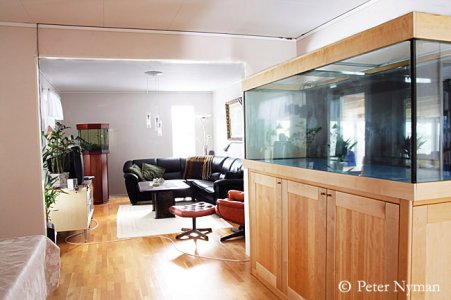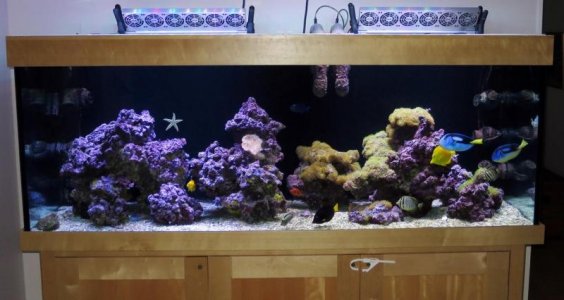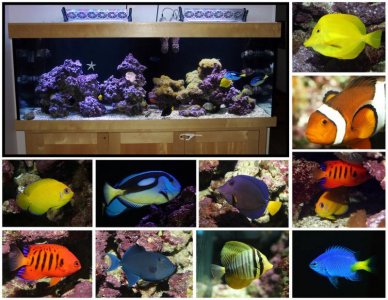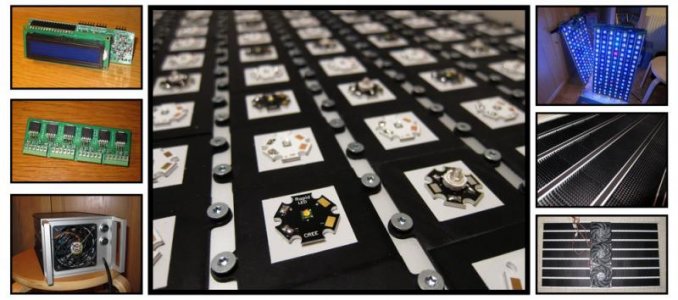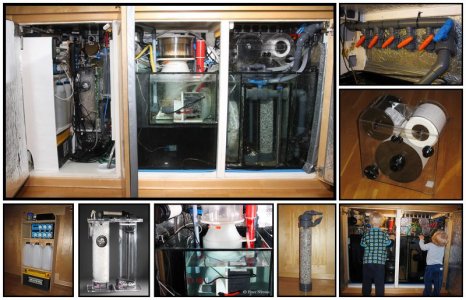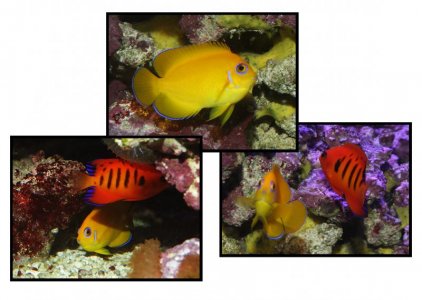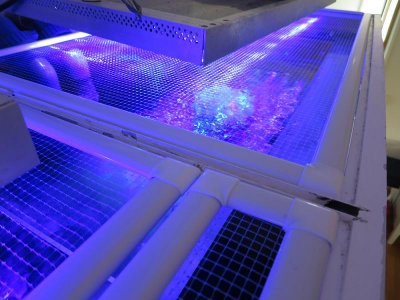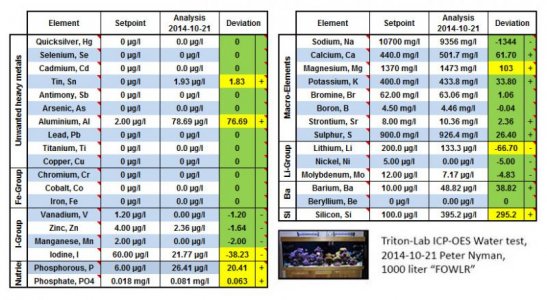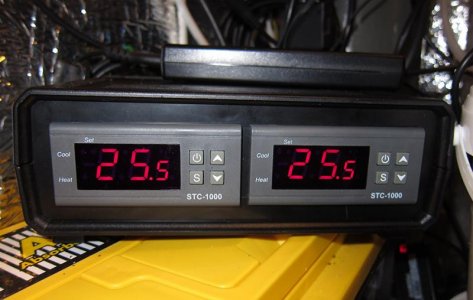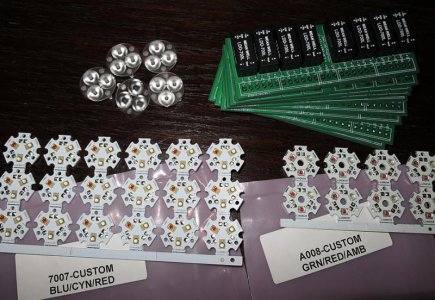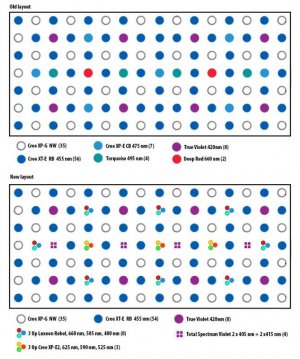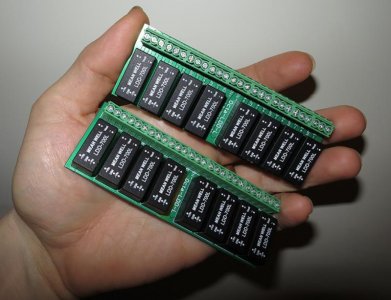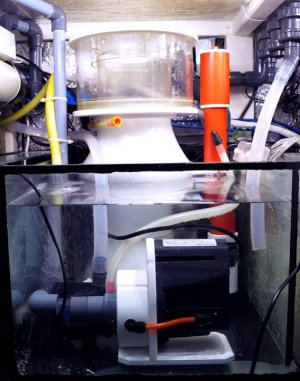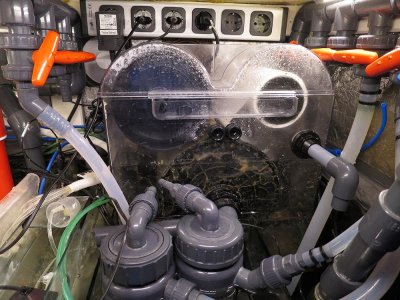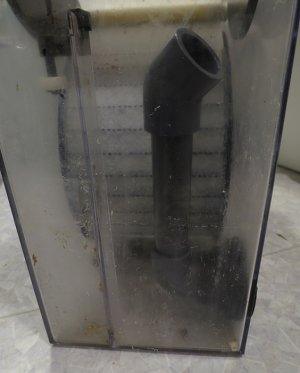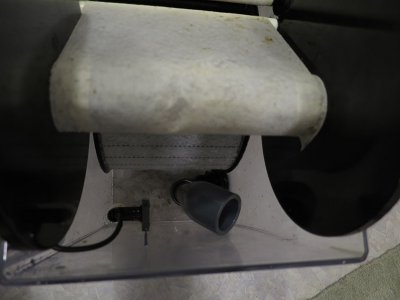Pny
New member
Introduction - This tank was setup about 7 years ago as my very first marine / reef tank. A short time later, after having two children, I realized that my time and economy did not let me grow this large tank into a full blown reef tank at that time. Instead it has been running as a FOWLR with just a few corals, mostly green star polyps and mushrooms. A year ago I set up a smaller 200 liter reef cube and got hooked on corals again. Now its time to take the O out of FOWLR and convert my large tank to a mixed reef! This thread covers my 1000 liter FOWLR to mixed reef conversion project.
Plan
The planning / main challenges for this project will be:
1, Reduce the coral chemÃcal warfare by reducing the amount of mushrooms. I currently have hundreds of Rhodactis indosinensis that also houses some pests.
2, Control of existing flatworm pests by removing most mushrooms, (that houses them), adding a few mandarin dragonets, (that might eat them), and eventually use some chemicals (that hopefully kills the last of them).
3, Upgrade / modify the LED lights to a setup with a bit more violet, 400-420 nm, (for the growth) and improve the area coverage of colors; red, green, cyan, amber, cold blue, etc (for the looks).
4, Reduce phosphates (PO4) and Nitrates (NO3) and simplify future export of nutrients. I've been using carbon source for years but it clogs my mechanical filter so I've been looking for alternatives. I've been experimenting with algae scrubbers, denitrifying media such as Seachem Matrix and Sera Siporax, and the Prodibio range of additatives, but still have to find the right method for my tank.
5, Introduction of corals by taking frags from my 200 liter reef cube.

Tank Description
Live stock - The display tank houses 7 Tangs, 4 Dwarf Angels and a few other fish.
Filtration - The aquarium is running on a modern version of the Berlin method, ie filtering is handled by live rock and an efficient skimmer, combined with modern methods of mechanical filtration, phosphate absorption and dosage of carbon source. The tank contains over 120 kg (260 lbs) of live rock. Two DIY upflow filters is used for media and a rollermat filter (Theiling) helps remove particles from the water.
Aquarium - The main display is a standard glass tank with eurobracing. The aquarium is a 980 liter (260 US gallons) glass tank, 200 x 70 x 70 cm, in 12mm glass with black background and black silicon.
Tank stand (DIY) - The aquarium stand is a wooden stand with doors from IKEA. The tank base is about 1 meter above the floor so it provides plenty of room for my sump and equipment inside the stand. I also like the idea of being able to look straight into the tank in standing position. The stand is isolated with sound proofing foam. Two fans ventilates the stand.
Sump (DIY) - The sump is a 380 liter (100 US gallons) tank measuring 115 x 54 x 60 cm in 10mm glass with black background. The sump is placed inside the stand under the display tank. The sump is partitioned into four sections. The sump holds about 100 liter fresh water for top off. The design allow water to flow back into the fresh water reserve instead of out on the floor in case of a failure of the equipment controlling the ATO. The return pump has its own section at the right side of the sump and the skimmer has its own section above the fresh water reservoir. A water change section holds about 100 liter water and allows me to mix new saltwater while the rest of the system is running without using any external buckets.
LED Light (DIY) - The light is a full spectrum DIY (2x275 W) LED fixture with DIY LED driver and DIY LED controller. The LED drivers was originally CAT4101 circuits but will be a mix of CAT4101 and Meanwell LDD-700L drivers. The LED controller is a very slim Arduino based stand alone 16 chn PWM controller with LCD, FAN control and RTC with battery backup.
Overflow (DIY) - The aquarium has a DIY PVC overflow made entirely from PVC pipes (no box required), utilizing a two pipe full siphon design for silent operation.
Return Pump - A powerful Laguna pump pushes 6000 liter/h (1500 gallons per hour) to my tank and reactors through a pipe manifold (DIY).
Circulation - The water movement in the tank is generated by five stream pumps each delivering a flow of 13.000 liter per hour. A controller (Tunze 7095) pulses the flow between the pumps. About half of the pumps is using the new wide flow outlets provided by Tunze.
Top Off - Top off is controlled by an ATO. The fresh water reserve is a section inside the sump. The ATO section holds water for about 1.5-2 weeks between refills. I refill this container manually. The water is filtered by a five stage reverse osmosis unit that produces water for both my tanks. The RO has a booster pump and is capable of generating 400 gpd. The water quality is measured with an inline TDS meter on the RO.
Waterchanges - I try to change about 10% of water every to every second month. I create RO/DI water in the utility area of my house, and mix new saltwater directly in the sump.
Ca Mg Alk and Carbon Supplement - A 3 channel dosing pump adds Alkalinity (NaHCO3), Calcium (CaCl2) and carbon source (12% acetic acid) to the tank. Mg and Iodine is added manually.
Temperature Control (DIY) - A DIY STC-1000 temperature controller regulates the temperature by controlling the fans and heaters. Two cooling sets with six fans each provides cooling during the summer.
Ozone and UV filters - Ozone is supplemented a few hour each night. This makes the water clear. The ozone is mixed with water in an Ozone reactor and the water and air is post filtered in a reactor filled with 3 liter carbon (GAC). ORP is supervised using a Pinpoint ORP-meter. Additionally a UVC filter is attached to the full siphon drain pipe from the aquarium.

System Profile
System Water Volume: 1040 liter (275 US gallons)
Display tank: 200x70x70cm, 980 liter glass tank
Sump: 115x54x60cm DIY glass sump with a built in ATO reservoir
Display Stand: DIY stand based on IKEA kitchen doors
Equipment
Lighting: 2x275W DIY LED, mainly Cree XT-E and Cree XP-G
Skimmer: Royal Exclusive Bubble King Supermarine 250 internal
Return Pump: Laguna PT344 Max Flo 6000 (6000 l/h - 1500 gallons/h)
Circulation: 5x Tunze stream 2 610x, each 13.000 liter/h
ATO: Tunze Osmolator 3155 with 100 l reservoir in sump
Filter: Theiling Rollermat automatic mechanical filter roll
Temp Control: Dual DIY STC-1000 Temperature Controller
Heater: Jaeger 2x300 W
Fan: 2x GHL PropellerBreeze II 6
Dosing: Kamoer 3 chn
Other Reactors: DIY upflow reactor (x2)
Ozone: Avast Mutiny II and custom postfilter
UV-filter: De Bary AN-25E
Auto Feeder: 2x Eheim 3581
RO/DI: Saturn 5 stage 400 gpd Reverse osmosis

Livestock
Fish
Blue Tang, Paracanthurus hepatus (x2)
Purple Tang, Zebrasoma xanthurum
Sailfin Tang, Zebrasoma veliferum
Red Sea Sailfin Tang, Zebrasoma desjardini
Yellow Tang, Zebrasoma flavescens
Lipstick Tang, Naso lituratus
Red-toothed Trigger, Odonus niger
Flame Angel, Centropyge loricula (x3)
Lemonpeel Angel, Centropyge flavissima
Yellowtail Damsel, Chrysiptera parasema
Clownfish, Amphiprion ocellaris (x2)
Invertebrates
Assorted snails
Red-legged hermits
Peppermint Shrimps, Lysmata wurdemanni
Corals
Green star polyp, Pachyclavularia violacea
Hairy Mushroom, Rhodactis indosinensis
Blue Discosoma Mushroom, Discosoma sp.
Umbrella Leather Coral, Sarcophyton sp..
Mint green Ricordea florida mushrooms, Ricordea sp.
Water Parameter Targets
Salinity: 1.025 (Refractometer)
Temperature: 26.0 C (STC-1000)
Alkalinity: 8.6 dKH (Hanna)
Calcium: 460 ppm (Salifert)
Magnesium: 1350 dKH (Salifert)
Nitrate: 2 ppm (Red Sea / Salifert)
Phosphate: 0.06 ppm (Hanna)

Above: Tank just setup (many years ago).

Above: My 2 x 275 W DIY LED project
Plan
The planning / main challenges for this project will be:
1, Reduce the coral chemÃcal warfare by reducing the amount of mushrooms. I currently have hundreds of Rhodactis indosinensis that also houses some pests.
2, Control of existing flatworm pests by removing most mushrooms, (that houses them), adding a few mandarin dragonets, (that might eat them), and eventually use some chemicals (that hopefully kills the last of them).
3, Upgrade / modify the LED lights to a setup with a bit more violet, 400-420 nm, (for the growth) and improve the area coverage of colors; red, green, cyan, amber, cold blue, etc (for the looks).
4, Reduce phosphates (PO4) and Nitrates (NO3) and simplify future export of nutrients. I've been using carbon source for years but it clogs my mechanical filter so I've been looking for alternatives. I've been experimenting with algae scrubbers, denitrifying media such as Seachem Matrix and Sera Siporax, and the Prodibio range of additatives, but still have to find the right method for my tank.
5, Introduction of corals by taking frags from my 200 liter reef cube.
Tank Description
Live stock - The display tank houses 7 Tangs, 4 Dwarf Angels and a few other fish.
Filtration - The aquarium is running on a modern version of the Berlin method, ie filtering is handled by live rock and an efficient skimmer, combined with modern methods of mechanical filtration, phosphate absorption and dosage of carbon source. The tank contains over 120 kg (260 lbs) of live rock. Two DIY upflow filters is used for media and a rollermat filter (Theiling) helps remove particles from the water.
Aquarium - The main display is a standard glass tank with eurobracing. The aquarium is a 980 liter (260 US gallons) glass tank, 200 x 70 x 70 cm, in 12mm glass with black background and black silicon.
Tank stand (DIY) - The aquarium stand is a wooden stand with doors from IKEA. The tank base is about 1 meter above the floor so it provides plenty of room for my sump and equipment inside the stand. I also like the idea of being able to look straight into the tank in standing position. The stand is isolated with sound proofing foam. Two fans ventilates the stand.
Sump (DIY) - The sump is a 380 liter (100 US gallons) tank measuring 115 x 54 x 60 cm in 10mm glass with black background. The sump is placed inside the stand under the display tank. The sump is partitioned into four sections. The sump holds about 100 liter fresh water for top off. The design allow water to flow back into the fresh water reserve instead of out on the floor in case of a failure of the equipment controlling the ATO. The return pump has its own section at the right side of the sump and the skimmer has its own section above the fresh water reservoir. A water change section holds about 100 liter water and allows me to mix new saltwater while the rest of the system is running without using any external buckets.
LED Light (DIY) - The light is a full spectrum DIY (2x275 W) LED fixture with DIY LED driver and DIY LED controller. The LED drivers was originally CAT4101 circuits but will be a mix of CAT4101 and Meanwell LDD-700L drivers. The LED controller is a very slim Arduino based stand alone 16 chn PWM controller with LCD, FAN control and RTC with battery backup.
Overflow (DIY) - The aquarium has a DIY PVC overflow made entirely from PVC pipes (no box required), utilizing a two pipe full siphon design for silent operation.
Return Pump - A powerful Laguna pump pushes 6000 liter/h (1500 gallons per hour) to my tank and reactors through a pipe manifold (DIY).
Circulation - The water movement in the tank is generated by five stream pumps each delivering a flow of 13.000 liter per hour. A controller (Tunze 7095) pulses the flow between the pumps. About half of the pumps is using the new wide flow outlets provided by Tunze.
Top Off - Top off is controlled by an ATO. The fresh water reserve is a section inside the sump. The ATO section holds water for about 1.5-2 weeks between refills. I refill this container manually. The water is filtered by a five stage reverse osmosis unit that produces water for both my tanks. The RO has a booster pump and is capable of generating 400 gpd. The water quality is measured with an inline TDS meter on the RO.
Waterchanges - I try to change about 10% of water every to every second month. I create RO/DI water in the utility area of my house, and mix new saltwater directly in the sump.
Ca Mg Alk and Carbon Supplement - A 3 channel dosing pump adds Alkalinity (NaHCO3), Calcium (CaCl2) and carbon source (12% acetic acid) to the tank. Mg and Iodine is added manually.
Temperature Control (DIY) - A DIY STC-1000 temperature controller regulates the temperature by controlling the fans and heaters. Two cooling sets with six fans each provides cooling during the summer.
Ozone and UV filters - Ozone is supplemented a few hour each night. This makes the water clear. The ozone is mixed with water in an Ozone reactor and the water and air is post filtered in a reactor filled with 3 liter carbon (GAC). ORP is supervised using a Pinpoint ORP-meter. Additionally a UVC filter is attached to the full siphon drain pipe from the aquarium.
System Profile
System Water Volume: 1040 liter (275 US gallons)
Display tank: 200x70x70cm, 980 liter glass tank
Sump: 115x54x60cm DIY glass sump with a built in ATO reservoir
Display Stand: DIY stand based on IKEA kitchen doors
Equipment
Lighting: 2x275W DIY LED, mainly Cree XT-E and Cree XP-G
Skimmer: Royal Exclusive Bubble King Supermarine 250 internal
Return Pump: Laguna PT344 Max Flo 6000 (6000 l/h - 1500 gallons/h)
Circulation: 5x Tunze stream 2 610x, each 13.000 liter/h
ATO: Tunze Osmolator 3155 with 100 l reservoir in sump
Filter: Theiling Rollermat automatic mechanical filter roll
Temp Control: Dual DIY STC-1000 Temperature Controller
Heater: Jaeger 2x300 W
Fan: 2x GHL PropellerBreeze II 6
Dosing: Kamoer 3 chn
Other Reactors: DIY upflow reactor (x2)
Ozone: Avast Mutiny II and custom postfilter
UV-filter: De Bary AN-25E
Auto Feeder: 2x Eheim 3581
RO/DI: Saturn 5 stage 400 gpd Reverse osmosis
Livestock
Fish
Blue Tang, Paracanthurus hepatus (x2)
Purple Tang, Zebrasoma xanthurum
Sailfin Tang, Zebrasoma veliferum
Red Sea Sailfin Tang, Zebrasoma desjardini
Yellow Tang, Zebrasoma flavescens
Lipstick Tang, Naso lituratus
Red-toothed Trigger, Odonus niger
Flame Angel, Centropyge loricula (x3)
Lemonpeel Angel, Centropyge flavissima
Yellowtail Damsel, Chrysiptera parasema
Clownfish, Amphiprion ocellaris (x2)
Invertebrates
Assorted snails
Red-legged hermits
Peppermint Shrimps, Lysmata wurdemanni
Corals
Green star polyp, Pachyclavularia violacea
Hairy Mushroom, Rhodactis indosinensis
Blue Discosoma Mushroom, Discosoma sp.
Umbrella Leather Coral, Sarcophyton sp..
Mint green Ricordea florida mushrooms, Ricordea sp.
Water Parameter Targets
Salinity: 1.025 (Refractometer)
Temperature: 26.0 C (STC-1000)
Alkalinity: 8.6 dKH (Hanna)
Calcium: 460 ppm (Salifert)
Magnesium: 1350 dKH (Salifert)
Nitrate: 2 ppm (Red Sea / Salifert)
Phosphate: 0.06 ppm (Hanna)
Above: Tank just setup (many years ago).
Above: My 2 x 275 W DIY LED project

